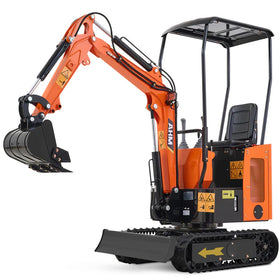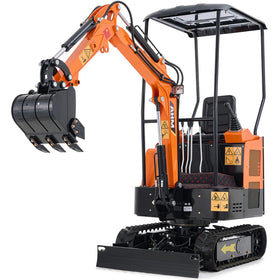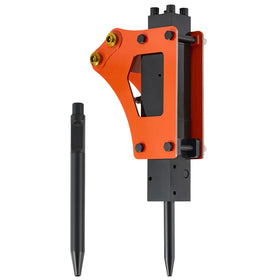The difference between profitable operations and budget-crushing breakdowns comes down to recognizing failure patterns before they happen.
Most operators learn this the hard way when a $75 cutting edge destroys a $1,200 bucket because they waited too long to replace it. Or when a leaking $150 hydraulic coupler contaminates the entire system, turning a simple fix into a $2,000 nightmare.
As any skid steer owner would know, emergency repairs often cost 4-5 times more than a planned replacement. For example, a $200 hydraulic cylinder seal can easily become a $1,100 field service call when it blows during a critical job.
Considering that your skid steer generates $300-500 per operating day, it’s easy to see how every unplanned breakdown ends up costing you big time.
Here are the top 10 most vulnerable components of your skid steer loader that may break down most often, and how much it might cost to fix or replace them.

1. Hydraulic Cylinders
Every hydraulic cylinder on a skid steer has to handle 2,000-3,000 PSI with hundreds of daily cycles. When it comes to cylinders, seal failure accounts for 85% of problems, typically occurring between 1,500-2,500 operating hours.
What causes Hydraulic Cylinders failures: Dirty hydraulic fluid and side-loading your bucket (using it to push rather than lift) puts lateral stress on cylinder rods that they're simply not designed to handle.
Real cost of hydraulic cylinder repairs: Professional cylinder rebuilds run $400-800, while complete replacements cost $600-1,200. DIY rebuild kits seem cheap at $60-100, but remember that they require specialized tools and 6-8 hours of your time to install.
2. The Bucket Cutting Edges
The cutting edges of your skid steer come into contact with abrasive materials thousands of times daily, wearing 1/4 inch per 200-400 hours in rocky conditions. On the other hand, removing winter snow on concrete can destroy a new edge in a mere 100 hours.
What causes Bucket Cutting Edges failures: Operating on asphalt instead of soil, excessive down pressure, and failing to rotate reversible edges when they are 50% worn.
Cutting Edge replacement costs: Standard bolt-on edges run $150-300. Wide-format edges for 84-96 inch buckets cost $400-600. Don’t forget to factor in professional installation, which adds $200-400.
3. The Hydraulic Quick Couplers
Flat-face couplers are designed to handle 500+ monthly connection cycles while fighting hydraulic fluid contamination. The internal valve springs weaken after 2,000-3,000 cycles, causing poor connections and pressure loss.
Connecting under pressure, mixing coupler brands, and storing without dust caps are the main reasons why hydraulic quick couplers wear down and break. Contaminated hydraulic fluid acts like liquid sandpaper.
Hydraulic Coupler replacement costs: Professional flat-face coupler sets cost $200-500 per pair. Make sure to factor in 3-4 hours of downtime for replacement and bleeding the system.
4. The Hydraulic Hoses
High-pressure hydraulic hoses on your skid steer have to endure 2,000+ PSI of pressure while flexing constantly. Most failures happen at the crimp connections, where all that stress concentrates. Under normal conditions, the service life of hoses on these machines falls around the 3-5 year mark.

What causes Hydraulic Hose failures: Temperature cycling from -10°F to 150°F, constant flexing beyond minimum bend radius, and UV exposure, which degrades rubber compounds.
Hydraulic Hose replacement costs: Standard hoses cost $75-200 each, while high-flow ones run $200-350. Emergency field service adds $200-400 in labor charges to the repair cost.
5. The Bucket Pins and Bushings
When you’re operating a skid steer, the bucket pins often rotate under loads exceeding 40,000 pounds. The bronze bushings on it wear against hardened steel pins while maintaining precise clearances that are down to tenths of millimeters, sometimes even less.
Insufficient greasing and side-loading beyond the design limits of the skid steer can cause the hydraulic pins to fail. Operating without greasing daily can accelerate bucket pin and bushing wear rates by 300-500%.
Bucket Pin and Bushing replacement costs: Individual pins cost $100-200, with bushings running at $15-35 each. Professional installation with line boring will cost around $800-1,800 in total.
6. Tilt Cylinder Pins
Tilt cylinders handle complex multi-directional stresses through 45-60 degree arcs. Using bucket curl to lift instead of the main lift arms, and aggressive movements that shock-load the tilt system may cause them to fail eventually. Over time, the pins wear out, reducing the precision of bucket control and accelerating the wear on the connected cylinder.
Tilt pins cost $150-250 each. Total replacement, including bushings and seals, ranges from $300 to 500 per cylinder.
7. Hydraulic Filters
Standard filters are designed to handle 5-25 micron particles, but daily operations on a skid steer generate much larger contaminants. Worn seals, dirty fill practices, and damaged breather caps allow moisture to get in can cause hydraulic filters to become contaminated. Operating this way beyond 250-500 hour intervals will cause the bypass valve to activate.
Standard filters cost $35-100. Emergency changes add $150-300 service charges plus system flushing costs.

8. Boom Pivot Bushings
Boom pivots handle the full lifting force put on your skid steer - up to 10,000+ pounds. Constant movements under heavy loads wear out the bushings against steel pins. Shock loading from dropped loads and using machines for dozing the ground will accelerate the wear as high as 200-300%.
Bushings cost $75-200 each, and typically, 6-10 are required. Professional installation with alignment boring will run $600-1,000 for the complete job.
9. Quick-Attach Plate Bushings
Quick-attach plates handle attachment weight plus working loads through small pin contact areas. Most manufacturers use identical pin sizes across different machine capacities, which causes overstressing on larger machines.
Frequent attachment changes and improper procedures that side-loading pins can make the bushings wear out. Commercial operators see 2-3 times faster wear rates.
Complete plate replacement costs $1,200-3,500. Additionally, aftermarket bore repair services typically cost $400-1,000.
10. Hydraulic Pump Drive Coupling
Drive couplings transfer engine power through flexible elements that fatigue from constant loading and the extreme temperatures they have to go through. Cold weather increases failure rates by a further 60-80%.
What causes Hydraulic Pump Drive Coupling failures: Engine RPM variations, pressure spikes, and operating with low hydraulic fluid levels.
Hydraulic Pump Drive Coupling replacement cost: Replacement couplings cost $300-800, and labor adds $600-1,200, making total repairs $900-2,000.
High-Quality Skid Steers from AHM
The AHM SS-38 mini skid steer has been designed with preventing common failures in mind. At 1,733 lbs operating weight with 827 lb lift capacity, it's properly sized to handle standard attachments without leading to stress-related failures.
The SS-38's quick-change system works wonders with root grapples, stump grinders, and augers without overstressing hydraulic components.
The 23 HP Briggs & Stratton engine provides consistent hydraulic flow for up to 7 hours of operation without the pressure spikes that destroy components in other machines.
Tool-free hood access and visible grease points mean that you can perform routine maintenance on schedule without hassle. The 45.3-inch width and 30-degree climbing capability handle demanding applications while maintaining reasonable stress levels on the internals.
The Bottom Line
Understanding which skid steer loader parts break most often isn't about accepting failure; it's about managing it without breaking the bank. These 10 components account for 80% of unplanned downtime and emergency repair costs.

So, whether you're running a skid steer for residential work or managing larger machines, know what will fail, plan for them, and keep working while your competition is waiting for service trucks.
For high-quality replacement components for your mini excavator, check out this complete list of skid steer loader attachments from AHM Corps.







